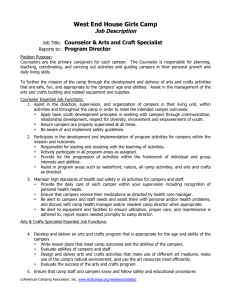Problem Solving Analysis Method:
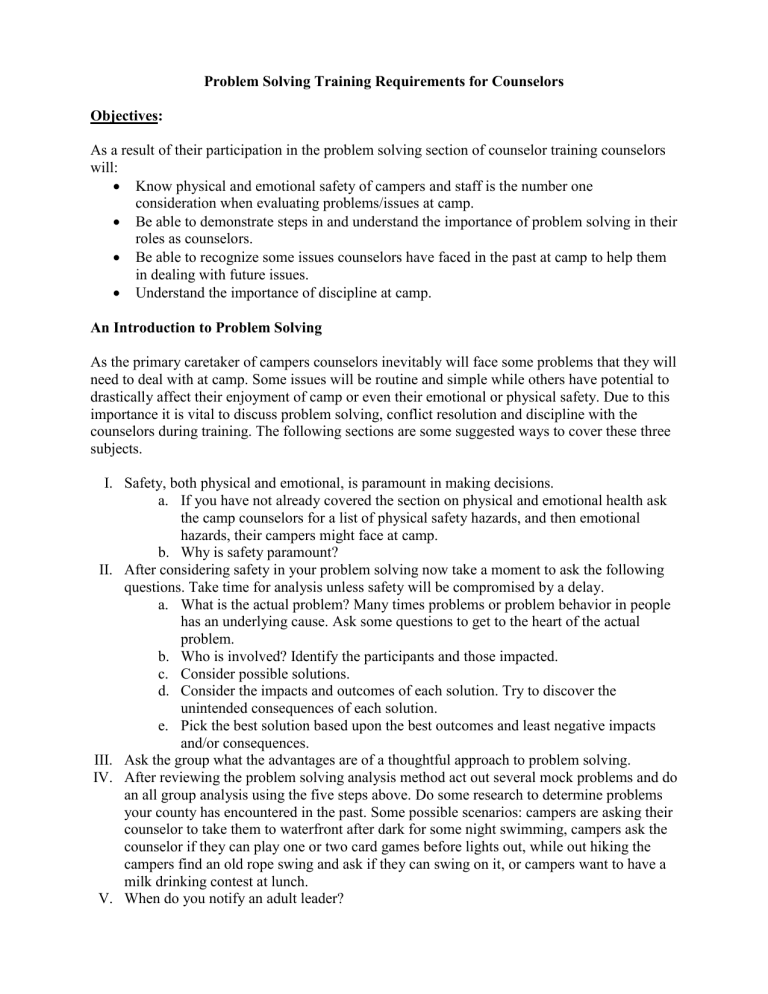
Problem Solving Training Requirements for Counselors
Objectives:
As a result of their participation in the problem solving section of counselor training counselors will:
Know physical and emotional safety of campers and staff is the number one consideration when evaluating problems/issues at camp.
Be able to demonstrate steps in and understand the importance of problem solving in their roles as counselors.
Be able to recognize some issues counselors have faced in the past at camp to help them in dealing with future issues.
Understand the importance of discipline at camp.
An Introduction to Problem Solving
As the primary caretaker of campers counselors inevitably will face some problems that they will need to deal with at camp. Some issues will be routine and simple while others have potential to drastically affect their enjoyment of camp or even their emotional or physical safety. Due to this importance it is vital to discuss problem solving, conflict resolution and discipline with the counselors during training. The following sections are some suggested ways to cover these three subjects.
I.
Safety, both physical and emotional, is paramount in making decisions. a.
If you have not already covered the section on physical and emotional health ask the camp counselors for a list of physical safety hazards, and then emotional hazards, their campers might face at camp. b.
Why is safety paramount?
II.
After considering safety in your problem solving now take a moment to ask the following questions. Take time for analysis unless safety will be compromised by a delay. a.
What is the actual problem? Many times problems or problem behavior in people has an underlying cause. Ask some questions to get to the heart of the actual problem. b.
Who is involved? Identify the participants and those impacted. c.
Consider possible solutions. d.
Consider the impacts and outcomes of each solution. Try to discover the unintended consequences of each solution. e.
Pick the best solution based upon the best outcomes and least negative impacts and/or consequences.
III.
Ask the group what the advantages are of a thoughtful approach to problem solving.
IV.
After reviewing the problem solving analysis method act out several mock problems and do an all group analysis using the five steps above. Do some research to determine problems your county has encountered in the past. Some possible scenarios: campers are asking their counselor to take them to waterfront after dark for some night swimming, campers ask the counselor if they can play one or two card games before lights out, while out hiking the campers find an old rope swing and ask if they can swing on it, or campers want to have a milk drinking contest at lunch.
V.
When do you notify an adult leader?
Conflict resolution
I.
Many of the above situations will involve some conflict resolution. Ask the counselors to define conflict resolution. Conflict resolution is defined by the National Youth Violence
Prevention Resource Center as: “Conflict resolution is about teaching people new ways to work through and resolve disputes that don’t involve violence.”
II.
Why is conflict resolution important at camp?
III.
According to Crawford and Bodine in the report: “Conflict resolution: a guide to implementing programs in schools, youth-serving organizations, and community and juvenile justice situations” the steps involved in conflict resolution are: a.
Setting ground rules.
Agree to work together and set rules such as no namecalling, blaming, yelling or interrupting. b.
Listening.
Let each person describe their point of view without interruption. The point is to understand what a person wants and why they want it. c.
Finding common interests.
Establish facts and issues that everyone can agree on and determine what is important to each person. d.
Brainstorming possible solutions to the problem.
List all options without judging them or feeling that they must be carried out. Try to think of solutions where everyone gains something. e.
Discussing each person’s view of the proposed solutions.
Negotiate and try to reach a compromise that is acceptable to everyone involved. f.
Reaching an agreement. Each person should state his or her interpretation of the agreement. Try writing the agreement down and checking back at a later time to see how it is working.
IV.
In addition to the above steps keep in mind that camper conflicts can be loud, heated interactions that can escalate without intervention. It is your responsibility to maintain a calm and even tone in order to help cool the situation while you attempt to resolve it.
Sometimes you may need a brief camper cool down period before attempting resolution.
V.
As a group act out the individual conflict resolution steps and/or ask processing questions about each step.
VI.
Next act out several mock problems and do an all group analysis using the six steps above. Do some research to determine problems your county has encountered in the past.
Some possible scenarios: a camper is missing money and is accusing another camper of theft, during a game several campers accuse one another of cheating, your campers complain that one of the other campers is repeatedly using profanity.
VII.
When do you notify an adult leader?
Discipline
I.
At some point during camp you may need to discipline a camper or ask an adult leader to discipline a camper. What are some situations where discipline is necessary? What is the purpose of discipline? It is really for the protection of the campers.
II.
Your county or club should have a discipline policy. Write it on a dry erase board, project it with an overhead or LCD projector or provide a copy to the counselors. Discuss the steps and then act them out using audience participation.
III.
Next act out several mock disciplinary situations and do an all group analysis using your discipline policy. Do some research to determine problems your county has encountered
in the past. Some possible scenarios: bullying (define and discuss), hazing (define and discuss), first time rules violation, repeated rules violation, fights.
IV.
Some actions warrant an immediate dismissal from camp. List the offenses and define and discuss them. Why is this necessary? How do you remove a camper from camp?
National Youth Violence Prevention Resource Center. 19 February 2007 www.safeyouth.org/scripts/teens/conflict.asp#references
Crawford D, Bodine R. Conflict resolution: a guide to implementing programs in schools, youthserving organizations, and community and juvenile justice situations. Washington (DC): Office of Juvenile Justice and Delinquency Prevention, Department of Justice; 1996 Oct. NCJ 160935.
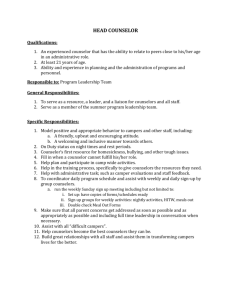
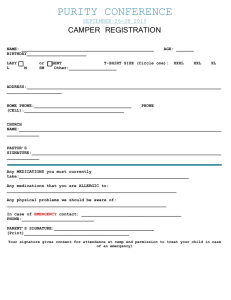

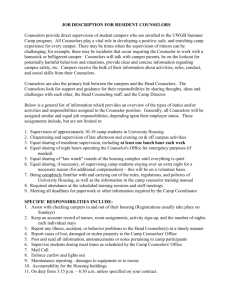


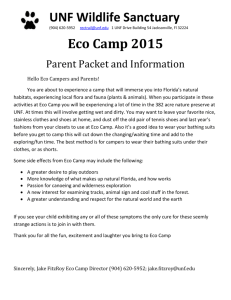
![Camper Report Form [Form] - American Camp Association](http://s3.studylib.net/store/data/006681677_1-c6987fc7adb7d5b820393417538bbe55-300x300.png)



